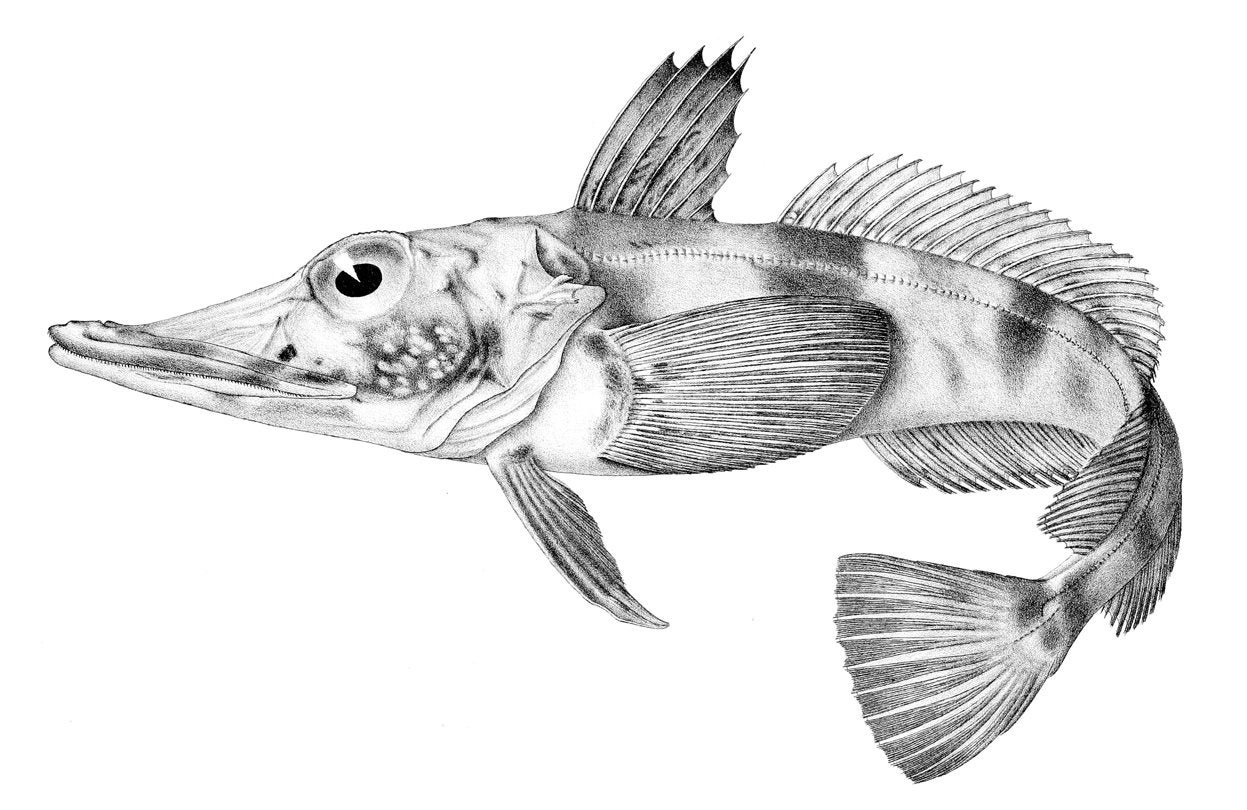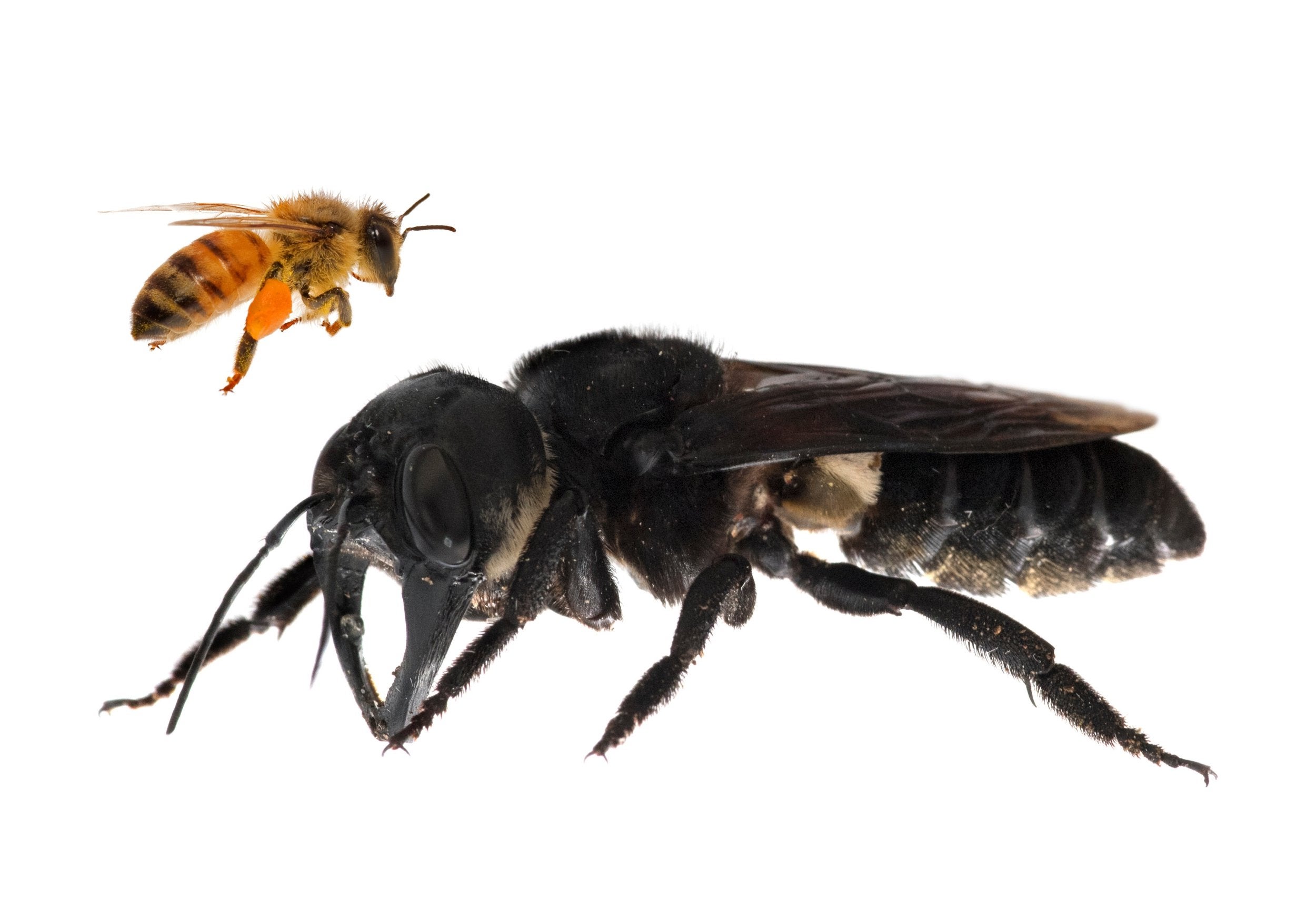Science roundup: From zebra stripes to a giant bee
Sleepless flies, a fish that can help with medical discoveries and a plot to smuggle Egyptian mummies; plus the other stories from around the world

Why do zebras have stripes? Scientists put them on horses to find out
What’s black, white and striped all over – except for its head?
Horses wearing zebra coats on a farm near Bristol.
The animals were dressed for studies investigating a mystery that has puzzled scientists for more than a century.
With solid coats of brown or gray, “most mammals are pretty boring,” said Tim Caro, who studies animal coloration at the University of California, Davis, and is a co-author of a study published recently in PLOS One.
“So when you see these bold patterns like on a giraffe or zebra, as a biologist you say, ‘Why?'”
Scientists have debated the function of this sassy animal print. Now most scientists agree that the function of a zebra’s stripes is to ward off biting flies that can carry deadly diseases.
Zebras in the wild are not easy to get close to. So Caro and a colleague, Martin How, went to Hill Livery, a horse farm moonlighting as an orphanage and a conservation hub for captive zebras near the University of Bristol in Britain. With their students, they observed and filmed horse flies trying to bite zebras. They also dressed some horses in zebra print to see if it helped them avoid fly bites.
The flies pestered all of the horses and the zebras in the paddocks equally. But once they got close, the zebra stripes seemed to dazzle the flies so much that they couldn’t manage a controlled landing. Flies zoomed in too fast and either veered off just in time – or simply bumped into the zebra and bounced off. The flies did not seem to like the zebra coats on horses, either, but their bare heads were fair game.
“Something is stopping the fly from realising that it’s close to making a landing,” Caro said. “We don’t know what that is, but stripes are exerting an effect to the very last second.”
The only thing they can say for certain is that the high contrast between black and white most likely tricks the fly’s low-resolution vision, which relies on sensing movement.
“It’s probably just blowing the fly’s vision away,” How said.

Who needs sleep? Not these flies
Sleep is so universal across the animal kingdom that we usually assume it is essential to survival. Now, however, scientists who repeatedly disturbed the sleep of more than 1,000 fruit flies are reporting that less slumber may be necessary for sustaining life than previously thought, at least in one species.
A handful of studies involving dogs and cockroaches going back to the late 19th century suggest that being deprived of sleep can result in a shortened life span. But the methods behind some of these studies can make it difficult to say whether the test subjects were harmed by sleep deprivation itself, or by the stress of the treatment they were given.
The new study took a milder approach, in hope of seeing the true effects of sleep deprivation. The automated system the researchers developed for monitoring the flies kept track of their movements with cameras, scoring any extended period without movement as sleep. When they were not being awakened repeatedly, the males slept about 10 hours a day, females about five on average.
To keep the flies awake, the researchers equipped the system with tiny motors that would gently tip the flies any time they went still for at least 20 seconds. With this method, researchers deprived flies of rest over the course of their entire lifetimes, tipping them hundreds of times a day such that if they were snoozing during those periods of stillness, they might have been able to sleep around 2.5 hours a day on average.
“When the results came from that experiment, it was very surprising,” said Giorgio Gilestro, a professor at Imperial College London who is a co-author of the study, which was published recently in Science Advances.
While female flies in the experiment died about 10 days sooner than other flies, male flies had completely normal life spans of about 50 days. Gilestro suggests that perhaps whatever sleep is doing in the way of essential maintenance can happen in a very, very short period of time, such that little sleep is required to keep an organism alive.
The study has limitations. It looked at only a single strain of fruit fly, said Dragana Rogulja, a professor at Harvard University who studies sleep using fruit flies.

It’s not hard to see how his brain works
The Antarctic Ocean was once warmer. Then about 30 million years ago, the temperature dropped. Few fish could survive temperatures that were just above seawater’s freezing point, and they either migrated to warmer waters or went extinct. One bottom-dweller held on. Through the power of natural selection, its descendants developed traits that let them survive these unlikely conditions. Today, the Antarctic blackfin icefish, or Chaenocephalus aceratus, thrives in these frigid waters with no scales, blood as clear as water, and bones so thin you can see its brain through its skull.
How this creature – no longer a bottom-dweller – can live in such a hostile environment has long fascinated scientists, who have mapped its genome and continued exploring its unusual traits. In a paper published recently in Nature Ecology and Evolution, a team of scientists compared the genome of the Antarctic blackfin icefish to those of its close relatives. They found that, across these genomic maps, and tens of millions of years of evolution, gene families had shrunken or expanded, giving rise to some of the icefish’s most unusual features. In addition to revealing how the icefish managed to adapt to extreme Antarctic conditions, the team’s findings provide a new way to look at the genetics behind human diseases such as anemia and osteoporosis.
“A trait that’s maladaptive in one environment can be adaptive in another,” said H William Detrich, a marine scientist at Northeastern University who has been studying icefish for decades and helped lead the study. He added that “we can learn a lot about human physiology and medicine by studying these evolutionary outliers.”
Frigid water holds more gasses, including oxygen, than warmer water does. But in water so cold, red blood becomes gunky, hard to pump and more likely to freeze. So the fish basically “evolved a therapy for anemia,” said John Postlethwait, a developmental biologist at the University of Oregon who also worked on the paper. It developed supersize gills and lost its scales, which enabled it to absorb the water’s plentiful oxygen through its skin. It also expanded its circulatory system with extra vasculature and a heart four times the size of closely related, red-blooded species.

Two mummies, or parts thereof, are kept off flight
Egyptian security officials at the Cairo International Airport recently foiled a plot to smuggle out of the country mummified limbs that were hidden inside a loudspeaker, Egypt’s Ministry of Antiquities announced. The contraband was to be loaded on a plane to Belgium when authorities spotted something strange on the X-rays.

In a hollowed-out speaker, they found six preserved body parts belonging to two different mummies: two sets of feet and lower legs; two sets of hands and forearms; an upper arm; and part of an upper torso, according to Iman Abdel-Raouf, an Egyptian official who works on archaeological matters. Authorities did not identify the smuggler or say whether any perpetrators were charged.
The recovered remains will be brought to the Egyptian Museum in Cairo so that a team of archaeologists can inspect and conserve them, according to the ministry. Their analysis could provide insight into the origins of these body parts and how they relate to other discoveries. Every artifact from Egypt’s past, no matter the size, helps shape scientists’ understanding of its ancient civilizations.
Grave robbing and smuggling have long troubled Egypt. Looting of ancient Egyptian artifacts escalated during the 2011 revolution, and the country has lost an estimated $3bn to illegal smuggling since then, according to the Antiquities Coalition, an American nonprofit that tracks the looting and trafficking of antiquities.
“So long as there is a demand for looted and stolen artifacts, thieves and traffickers are going to find the supply,” said Tess Davis, the coalition’s executive director. “It’s impossible to police all of the country all of the time.”
In 1983, the country enacted a law, known as Law No. 117, mandating that all antiquities, art and artifacts – mummies included – were to be strictly regulated and considered the property of Egypt. Anyone found guilty of smuggling such items from the country could face fines and up to two years in prison.

A bee absurdly big, and surprisingly alive
It has been 38 years since scientists last spotted the insect known as Wallace’s Giant Bee, a rare species found only in a group of Indonesian islands called the North Malukus. With a wingspan of 2.5 inches and a body the size of a human thumb, it’s considered the world’s largest bee, and was feared extinct.
Those fears can now be somewhat laid to rest. In January, an international team of conservationists found a Megachile pluto, as the species is called, in the wild. The team captured the first-ever photos and videos of a live specimen, renewing hope for survival of the species, which is threatened by deforestation.
“It’s just ridiculously large and so exciting,” said Simon Robson, a biologist at the University of Sydney in Australia and a member of the expedition.
The discovery did not come easily. Despite the bee’s size, its rarity, remote location and nesting habits make it difficult to find.
“I personally know of at least five attempts to find the bee,” said Clay Bolt, a photographer who was part of the latest expedition.
The bees make their homes by digging holes in the nests of tree-dwelling termites, where they spend much of their time hiding.
“It was a lot of walking around the forest in 90-degree heat and the highest possible humidity looking at termite nests and chasing after bees,” Robson said. In all, it took five days of hunting for the team to find their “holy grail”.
The expedition was partly funded by Global Wildlife Conservation, a Texas nonprofit that in 2017 started a global search for 25 “lost” species – animals that are not necessarily extinct but have not been spotted in at least a decade.
Excited as they were to find the bee, Robson and his team worry that the sighting may be a mixed blessing. Last year, an anonymous seller sold a previously unaccounted-for specimen to an unknown bidder on eBay for $9,100. “If you can get that much money for an insect, that encourages people to go and find them,” Robson said. To help protect the bees, the team has agreed not to disclose the exact island where they made their discovery.

© New York Times
Join our commenting forum
Join thought-provoking conversations, follow other Independent readers and see their replies
Comments
Bookmark popover
Removed from bookmarks